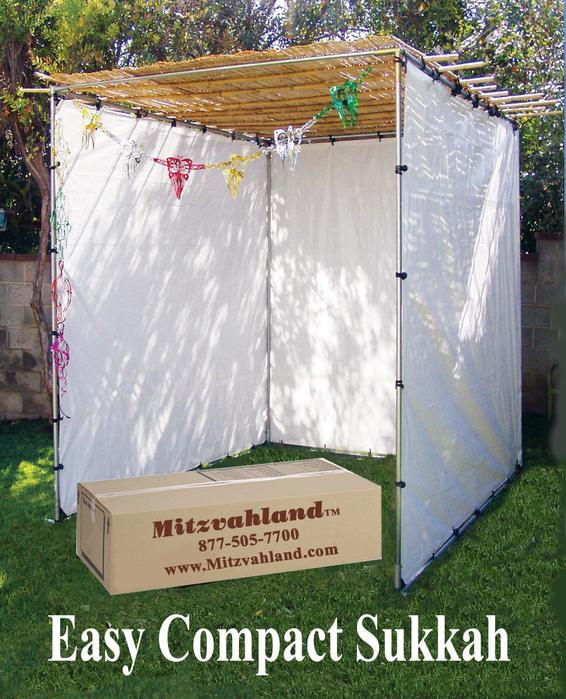How to construct a Sukkah?
First, put together the walls and then after put the roof covering (Schach) on top. The roof is to be made from material that naturally grows. There is no preference to the material used for the sukkah walls, as long as they are sturdy and durable enough to stand up against the force of an average gust of wind. When sheets or canvas is used for the sukkah walls, its important to bind them together tight to the frame so no wind will knock them out of place. If the walls sway they are not considered to be walls that may be officially used.
If the frame is constructed first, then the roof (schach) is placed on top, and after that the walls are put up, the sukkah is not considered to be fit for use. The walls would need to be built before the roof (schach) is placed on top for it be fit for use, but if the frame are at least (a handbreadth) wide, the roof may be placed on top before the walls are built.
If the schach on the roof before building the walls, a person can still make the sukkah ready to be used. Just follow these steps, lift the schach up from where it is and then let it down. When done like this, its as if the schach has now been placed on top of the sukkah.
If one built two complete walls, a third wall which is more than a tefach wide, and a doorway between the walls, the sukkah is fit for use. Nevertheless, it is preferable to build four full walls.
Not all materials can be used for sechach. The material used as sechach must be something of plant origin that is now detached from the ground. It may not have been previously used for another purpose. It must never have acquired the status of a utensil nor have been capable of becoming ritually impure. Thus, branches which have been cut from a tree, strips of wood, straw, and similar materials can be used for sechach. Boards which were previously part of a crate may not be used for sechach since they originate from a utensil. Similarly, one may not use materials which are edible and if one does so, the sukkah is not fit for use.
Boards that are four tefachim wide cannot be used for sechach even if they had never been used previously, for their width makes them look like the ceiling in a home.
If one built his sukkah under a tree whose branches cover the sukkah, the sukkah is unfit for use even if one also uses proper sechach. The branches are considered to be part of the sechach since they also cover the sukkah; and since sechach can only be taken from something that is detached from the ground, the sukkah is unfit.
The Sages did not approve of using malodorous materials for sechach. Similarly, one should not use branches whose leaves fall off easily since they spoil the sukkah and may cause the person to leave the sukkah. Moreover, if the leaves fall off easily, the sechach may become so scanty and diminished that the sukkah will become unfit for use, for the halachah states that there must be more shade than sunlight in the sukkah.
Regarding bundles of stalks: If there are twenty-five stalks in the bundle, they may not be used for sechach as long as they are bundled together. If, however, one placed the bundle on the roof of the sukkah [with the intention of using them as sechach] and then unbound them, they may be used as sechach.
A mat of stalks or straw which was made specifically to be used as sechach may be used even though it has other uses as well. Since it was specifically intended for use as sechach, it is not susceptible to ritual defilement and is therefore fit for use.
One must place a sufficient amount of sechach so that the resultant shadow inside the sukkah is greater than the sunlight. If the amount of sechach is not sufficient to make the shadowed area of the sukkah greater than the sunlit area, the sukkah is unfit for use.
On the other hand, one should not place an excessive amount of sechach on the sukkah, i.e., an amount that prevents one from seeing the larger stars in the night sky through the sechach. However, even if this amount of sechach is used, the sukkah is nevertheless fit for use provided that the sechach is not so dense that rain cannot penetrate.
One may not derive any benefit from the materials used to construct the sukkah and the sechach during the eight days of the Festival.
This is a traditional Sukkah perfect for Sukkah holiday, it is completely pre-fabricated for quick assembly and is pre-packaged in two concise boxes for easy shipping and storage. The frame of the Sukkah is made of aluminum making it sturdy and lightweight, and ensuring that it will not rust or corrode. Each piece of The Easy Compact Sukkah is able to be attached to each other, in a matter of minutes. Your hand is the only tool you will need to build your Sukkah!
Our Sukkah walls are made of white tarp panels, that attach to each other. Using the simple to follow detailed Sukkah instruction will help you to build your Easy Compact Sukkah in as little as 30- 45 minutes!! Take a look at our SUKKAH STORE HERE

Don’t forget your Sukkah Bamboo Mat that you need to cover the roof of the Sukkah- for this Sukkah you need 2 Bamboo Mat 5′ x 10′ (Schach) Come visit our store in Los Angeles (Mitzvahland 16733 Ventura Blvd, Encino 91436) and pick up your Easy Compact Sukkah Today!!!



Share:
How to Build a Mitzvahland Sukkah?
Best Quality Sukkah Roof Schach For your Sukkah